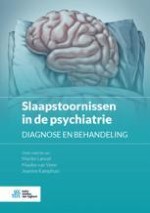Samenvatting
Circadiane slaap-waakritmestoornissen zijn slaap-waakverstoringen met een afwijkend 24-uurspatroon in de slaap-waakafwisseling. In de psychiatrische praktijk komt de vertraagd slaap-waakritmestoornis (DSPD) veruit het vaakst voor. De prevalentieschatting van DSPD in de algemene bevolking varieert van 0,1 tot 3 %, oplopend bij jongeren tot 16 %. Klachten zijn problemen met op de gewenste tijd in slaap vallen en ’s morgens niet op tijd wakker kunnen worden, met slaperigheid en vermoeidheid overdag. Op de gewenste, late tijd wordt wel normaal geslapen. Naar schatting 40 % van de mensen met DSPD heeft ook een psychiatrische diagnose, zoals een stemmings-, angst- of middelengerelateerde stoornis. Therapie van vooral vertraagd slaap-waakritmestoornissen moet zich richten op een gedragsmatige slaapbehandeling in combinatie met weinig licht in de avond, lichttherapie in de ochtend en eventueel een lage dosis melatonine zo’n 5 uur voor het in slaap vallen.
